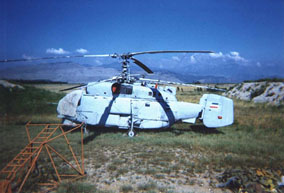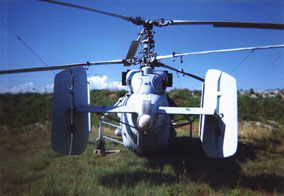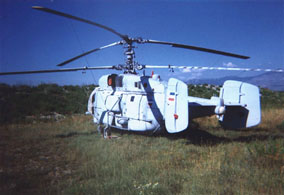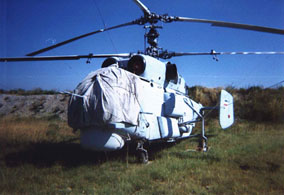Manufacturer: |
Kamov Design Bureau |
Country of origin: |
USSR |
 |
Class: |
Attack helicopter |
Type: |
Shipborne anti-submarine
and utility helicopter |
Specification: |
Ka-27PL ‘Helix-A’ |
Powerplant: |
Two Klimov (Isotov)
TV3-117V turboschafts each rated at 1645 kW |
Fuel capacity: Internal
fuel- not available plus provision for auxiliary fuel in two external tanks; external fuel
none; no provision for inflight refueling |
Dimensions: |
Rotor system: Rotor
diameter, each 15.90 m; rotor disc area, total 397.11 m |
Fuselage and tail
dimensions: Length, fuselage 11.30 m and 12.25 m with rotors folded; height overall 5.40 m
to top of rotor head; wheel track 1.40 m for the front unit and 3.50 for the rear unit;
wheel base 3.02 m |
Operational weights:
Empty 6100 kg; operating empty 6500 kg; normal take-off 11000 kg; maximum take-off 12600
kg |
 |
Performance: |
Maximum level speed
‘clean’ 250 km/h at optimum altitude; cruising speed, maximum 230 km/h at optimum
altitude |
Ferry range 800 km with
auxiliary fuel; endurance 4 hours 30 minutes |
Service ceiling 5000 m;
hovering ceiling 3500 m out of ground effect |
Crew: |
Flight crew of two or
three, and a mission crew of three, or passengers or 4000 kg or freight carried in the
hold, or 5000 kg of freight carried as a slung load |
Disposable
armaments: |
Up to about 2000 kg of
disposable stores carried in a lower-fuselage weapon bay, and generally comprising two
torpedoes or depth charges |
Electronics &
operational equipment: |
Standard communication
and navigation equipment, plus (offensive sensors) surveillance radar with its antenna in
an undernose radome, optronic sensor, either dunking sonar or MAD with its sensor in a
towed ‘bird’, and a two externally mounted option boxes of sonobuyos, (defensive
sensors and system) advanced ECM/ESM suite, and (cabin displays) acoustic data processing
system and tactical display system; the existence of other blisters and fairings on the
airframe indicates that other sensors and/or equipment are carried
|
Operators: |
USSR, former (100+) |
India (13) |
Yugoslavia, former (6) |
|
|
Variants: |
Ka-27PL ‘Helix-A’:
Designed from 1969 as successor to the Ka-25 ‘Hormone’ series and retaining the
earlier type’s configuration, the ‘Helix’ first flew in prototype from during
December 1974 and has considerably greater power and slightly greater dimensions for much
enhanced performance and payload within an airframe still able to fit into the same hangar
as the Ka-27. The ‘Helix-A’ is the dedicated ASW variant of the series, and was
introduced to service in 1982 with the significant advantage over the ‘Hormone-A’ that
it has a hover coupler allowing the dunking sonar to be used at night and in adverse
weather conditions. |
 |
Ka-28 ‘Helix-A’:
This is the export version of the ‘Helix-A’, powered by two Klimov (Isotov) TV3-117BK
turboshafts each rated 1620 kW and supplied with fuel from an internal weight of 3680 kg
carried in 12 tanks. The type is presumably delivered with a different (probably lower)
avionics standard. |
Ka-29TB ‘Helix-B’:
This is the dedicated Naval Infantry assault transport (with accommodation for 16 fully
equipped troops) and perhaps more importantly the ability to deliver precision-guided
weapons in support of amphibious landings. The type has substantial armor protection for
the cockpit and engine bay, and the embarked troops are carried in a hold 4.52 m long,
1.30 m wide and 1.32 m high. Rapid egress is facilitated by the provision on the port side
of the fuselage, behind the main landing gear unit, of a door horizontally divided into
upward- and downward- opening sections. The helicopter’s fixed armament comprises one
7.62 mm rotary four-barrel machine gun on a flexible mounting behind the downward-
articulated door on the starboard side of the nose, and one optional 30 mm 2A42 cannon on
a fixed mounting on the port side of the fuselage; the disposable armament is carried on
four hardpoints under braced outriggers, and comprises four-round launchers for AT-6
‘Spiral’ anti- tank missiles or UV-32-57 multiple launchers each carrying 55 mm
unguided rockets. This variant’s standard electronics include optronic and missile-
guidance pods under the nose, an ESM system with its antenna above the rear part of the
engine bay forward of the IR jammer, and an RWR. There is also an EW version of the
‘Helix-B’ thought to be optimized for the AEW or jamming role with equipment in three
panniers under the fuselage and on its sides, and in an extended tailcone. The other main
differences between the ‘Helix-A’ and ‘Helix-B’ include the latter’s powerplant
of two Klimov (Isotov) TV3-117VK turboschafts each rated at 1660 kW, wheel base of 3.00 m,
basic empty weight of 5520 kg, maximum level speed ‘clean’ of 265 km/h at sea level,
and range of 520 km with standard fuel. |
 |
The NATO reporting name ‘Helix-C’
has been given to the Ka-32 civil helicopter which can carry a planeload of 5000 kg
over a range of 180 km. |
Ka-27PS ‘Helix-D’:
this is the general- purpose member of the Ka-27 series that can be used in roles as
diverse as SAR, planeguard and under- way replenishment of warships at sea. Thought based
on the ‘Helix-A’, the type has the two external fuel tanks of the ‘Helix-C’ and is
fitted as standard with a rescue hoist.
special thanks to Luka
Baturan |
|